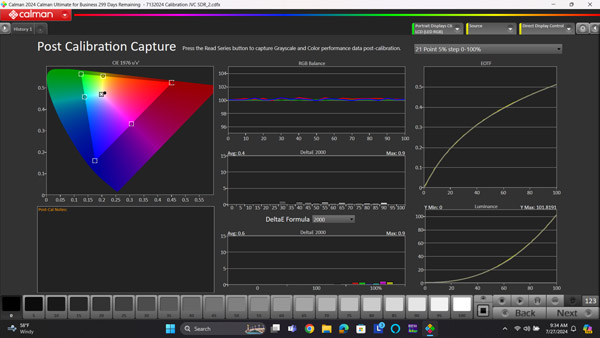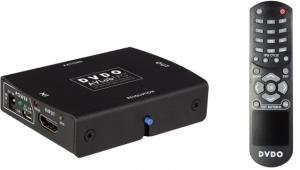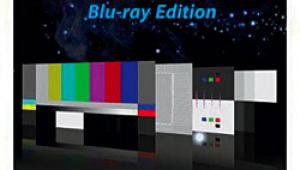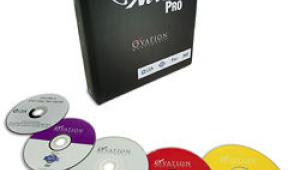Portrait Displays G1 Pattern Generator: Precision Calibration Anywhere, Anytime

$549
AT A GLANCE
Plus
Pixel perfect color accuracy
Easy setup and Ssamless interaction with Calman
Supports SDR, HDR10, HLG, and Dolby Vision
Field upgradable
Minus
Works only with Calman
Pricey compared to DIY options
THE VERDICT
A compact, portable device designed for high-precision display calibration, offering seamless integration with Calman software.
My first foray into calibrating displays came about 20 years ago when I purchased a Hitachi RPTV (remember those?) and discovered various online forums that talked about getting the most out of your display through calibration. In those days, the controls needed to perform a full calibration required one to enter the factory service menu, which at that time intimidated me enough to hire a professional calibrator to do the job.
Unfortunately, there weren’t many options in my area, and the gentleman I hired turned out to be a poor choice. I had to guide him on how to access the service menu, and I quickly realized I knew more about my display than he did. Although the picture was improved, I expected a professional to be more knowledgeable about the product he was working on.

However, the experience gave me an epiphany. With enough time and the right tools, I could learn to calibrate my own display.
Over the next few months, I read everything I could on the subject and decided to rent some equipment to see if I could do a better job myself. I can’t recall the name of the rental company, but it was based in the Midwest. For about $300, I rented a tristimulus colorimeter and got 30 days of access to their software.

Luckily, three of my friends had the same TV as mine, so we split the cost. Over two weekends, I used the rented equipment and a DVD copy of Digital Video Essentials, which included all the necessary patterns, to calibrate all of our TVs.
Over time, I became increasingly immersed in the AV world. I began reviewing movies and products for various publications, and my interest in display calibration only grew. Over the past 20 years, I’ve owned a range of projectors and direct-view displays. Since 2007, I’ve been using Calman software and various tristimulus colorimeters. I’ve also reviewed numerous displays, where calibration is a crucial part of the process to ensure consistent, apples-to-apples benchmarks during evaluations.
Currently, I own two versions of Portrait Display’s branded C6 colorimeters—a vintage C6 rated up to 1,000 nits (brightness of the display) as well as their new C6-HDR, which is rated up to 2,000 nits (a capability needed for modern HDR displays), and an X-Rite i1Pro 2 (Rev E), which struggles reading at near black levels, but shines when calibrating CMS (Color Management System).
With Calman software, the C6-HDR2000 is quite a powerful unit in its ability to read the lower end of the IRE spectrum. (IRE refers to measuring peak brightness. The IRE scale ranges from 0 to 100, with 0 representing complete black and 100 representing the brightest white.) I utilize both meters in a calibration by profiling the X-Rite to the C6, which gives me the best that both meters have to offer.
For years, I wanted to invest in a pattern generator but couldn’t justify the thousands of dollars it would cost. So, I stuck with calibration discs for accessing test patterns. While both methods provide accurate output, a pattern generator is much faster, as it integrates with the software and can quickly cycle through readings, unlike manually navigating through chapters on a disc.
In recent years, DIY options have emerged, allowing you to build your own generator using a Raspberry Pi (which I did). But an affordable, ready-made solution wasn’t available until earlier this year when Portrait Displays launched its G1 Pattern Generator for $549.
The Specs
The G1 is an excellent tool designed to streamline display calibration by offering a wide range of high-precision test patterns essential for accurately calibrating color, brightness, contrast, and other key display characteristics. It integrates exclusively and seamlessly with Calman software, enabling automated and precise calibration workflows.
Furthermore, the G1 contains the latest in HDR and UHDTV technologies including HDR10, HLG, and Dolby Vision and supports resolutions up to 4096x2160 at 60 Hz. Moreover, it’s field upgradable so it should be able to stay ahead of industry changes for the foreseeable future to adapt to evolving formats, standards, and protocols.
Portrait Displays designed the G1 with both functionality and portability in mind. Its compact size (2.5” W x 3.75” L x 0.625” H) and sturdy build make it ideal for professionals who perform calibrations in various locations, while its affordability also appeals to DIY enthusiasts.
The unit features a single HDMI 2.0 port that is HDCP 1.4 and 2.2 compliant, two USB ports (USB 3.0/2.0), and an RJ45 1GB Ethernet port. It also includes 2.4GHz Wi-Fi for remote connection to Calman software. The G1 is powered by a single USB-C input (5V-2A), though a power plug isn’t included. Most users will likely power the device through a USB port on their computer while calibrating their display.
Setting up the G1 on a Wi-Fi network is straightforward if you follow the Quick Start Guide included with the unit. I did encounter a connection issue, but it was entirely due to user error. For Calman to connect to the G1, both must be on the same 2.4 GHz network. I initially overlooked that my laptop had automatically connected to my 5 GHz network, preventing Calman from linking with the G1. Once I switched to the 2.4 GHz network, Calman connected seamlessly, and I was ready to go. (It’s worth noting that you can use a wired network if you have one available near your display device.)
In Use
I decided to test the G1 by calibrating several different displays to see how well it worked with the Calman software. First up was a vintage 2006 Vizio VP504, a 1080p plasma TV in my den. Although I’ve wanted to replace it with a new OLED for years, Mrs. Reviewer has consistently vetoed the idea since the Vizio rarely gets used and still delivers a decent picture. This display had been calibrated before using Calman, but with a Blu-ray copy of Digital Video Essentials providing the test patterns—a process that took over four hours. I was eager to see if the G1 could speed things up.

Fig.1 Post-calibration capture of the Vizio VP504 shows a marked improvement, with the grayscale Delta E reduced to 1.3 and color accuracy to a Delta E of 2.5. Despite limited control options, the calibration achieved an accurate and natural image.

Fig.2 Pre-calibration capture of the Vizio VP504 reveals inaccuracies in both grayscale and color, with an average Delta E of 8.8 for grayscale and 11.8 for color. The out-of-the-box settings produce a garish picture, indicating a strong need for calibration.
After resetting the TV to its default settings, I began the calibration. The Calman software instantly recognized the G1 pattern generator and even suggested the optimal settings for a 1080p calibration: D65 white point, REC.709 color space, ITU BT.1886 gamma, with 10% windows. Pre-calibration readings highlighted just how poor the display’s out-of-the-box settings were. The grayscale showed an average Delta E (dE) of 8.8, and the color registered at 11.8. Calling the picture ugly and garish would be an understatement.
Since the TV doesn’t offer autocalibration, I had to manually adjust the settings. Unfortunately, this display only provides “Cuts” for Red, Green, and Blue, with no controls for “Drives,” making calibration more challenging. The Cuts allowed me to adjust the lower IREs, but adjusting Contrast impacted the drives. Despite these limitations, the post-calibration report showed a significant improvement: an average dE of 1.3 for grayscale and 2.5 for color. Considering the display offers no CMS and has limited controls, these results were impressive. Remarkably, the entire calibration process took less than an hour, not including the 30 minutes needed to warm up the display. The G1 worked flawlessly, flying through the test patterns much faster than manually navigating a Blu-ray disc.
Next, I tackled my reference JVC RS3100 projector, calibrating it for both SDR and HDR. Fortunately, JVC provides its own calibration software, which performs well, especially with some aftermarket modifications. Typically, the software is compatible only with the Spyder X, which excels at reading low-light gamma but struggles with color accuracy, and the i1 Pro2, which is excellent for color but not ideal for low-light gamma readings. However, thanks to some ingenious programmers, I was able to use the C6-HDR2000 for auto-calibrating gamma and the i1 Pro for color, resulting in a much more accurate calibration.

Fig.3 Post-calibration capture of the JVC RS3100 demonstrates significant enhancements, with grayscale Delta E reduced to 0.7 and color accuracy brought down to a Delta E of 0.9. These adjustments result in near-perfect accuracy, delivering an exceptional picture.

Fig.4 Pre-calibration capture of the JVC RS3100 reveals significant discrepancies, with a grayscale Delta E of 8.8 and color accuracy at 11.8. These values underscore the need for calibration to achieve a more accurate and natural picture quality.
Although the auto-calibration process takes about an hour, it’s well worth the time, providing a solid baseline for manual adjustments. Post-auto-calibration readings showed the projector’s grayscale tracking with an average dE of 1.9 and color at 1.8—a dE between 3 and 5 is typically considered acceptable. The SDR calibration took about 45 minutes, and as expected, I was able to fine-tune the results significantly. The post-calibration grayscale had an average dE of 0.7, and color was 0.9. Once again, the G1 dramatically reduced the calibration time compared to using disc-based test patterns.
The HDR calibration was just as smooth, thanks to JVC’s auto-calibration. I only needed to make minor adjustments to the grayscale by slightly balancing the intensity of Red and Green in the mid-IRE ranges and raising the Picture Tone in the JVC gamma menu to +2. The projector’s frame-by-frame tone mapping yielded an exceptional image.
Finally, I tested the G1’s performance on a “Calman Ready” display—a 77” LG OLED (77C2AUA) owned by my neighbor. He only had a two-hour window, so I could only complete an SDR calibration, but I was thoroughly impressed by the process. Minimal input is required from the user: once the G1, Calman software, and display are on the same network, the calibration process is smooth as long as you follow the step-by-step instructions provided by the software.

Fig.5 Post-calibration capture of the LG OLED (77C2AUA) shows exceptional results, with grayscale Delta E reduced to 0.4 and color accuracy at 0.6. These precise adjustments deliver a highly accurate and vivid image, significantly enhancing the display's performance.

Fig.6 Pre-calibration capture of the LG OLED (77C2AUA) reveals moderate deviations, with a grayscale Delta E of 3.3 and color accuracy at 2.4. While the image is acceptable, there is room for improvement to achieve optimal accuracy through calibration.
The pre-calibration readings showed a dE of 3.3 for grayscale and 2.4 for color. The first step was to manually set the luminance (targeting 115 nits to give the calibration some headroom) before letting the software take over. Grayscale calibration took just over 28 minutes, resulting in an impressive average dE of 0.4. The next step was a 3D LUT, which also required minimal user input. Thirteen minutes later, the colors were dialed in with an average dE of 0.6. After a quick verification of luminance (which required raising the OLED light from 31 to 33), I performed a post-calibration capture to confirm the results.
My neighbor was thrilled with the SDR calibration, noting that the color separation looked more vivid and three-dimensional. From my perspective, it was the easiest and most accurate calibration I had ever performed. Even someone with limited technological know-how can achieve excellent results using the G1, C6-HDR2000, and Calman software. When my neighbor’s schedule permits, I’ll return to perform an HDR and Dolby Vision calibration to ensure he gets the most accurate picture possible.
Conclusion
The G1 Pattern Generator is primarily aimed at DIY calibrators, consumers, and hobbyists, and at $549, it’s reasonably priced. Technically inclined users could build their own pattern generator for about one-fifth of the G1’s cost, but they’d still need a software suite to use it—whether from Portrait Displays or a competitor. Unfortunately, Calman removed the ability for its Home software to interface with third-party pattern generators once the G1 launched, much to the chagrin of the enthusiast community. However, from a business perspective, it’s understandable why they’d prefer to maintain a closed ecosystem.
I believe the true target audience for the G1 includes owners of LG, Sony, Panasonic, Samsung, and Philips displays who have a DIY mindset and want the most accurate display without hiring a professional calibrator. These users can purchase a Calman Home Bundle with the G1 and a C6-HDR2000 colorimeter for $649 and, with a little time and effort, calibrate their display for just slightly more than the cost of a single professional calibration. For those who already own a colorimeter, the cost of entry drops to just $349, which is an absolute steal for what the G1 offers.
As a hobbyist myself, I’m adding the G1 to my arsenal of calibration tools. The time savings it offers over calibration discs is substantial, and its seamless integration with Calman software—my calibration software of choice for more than 17 years—is a significant bonus.
Complete specs and more information is available the Portrait Displays official site.
























































